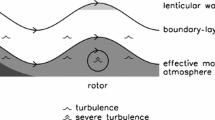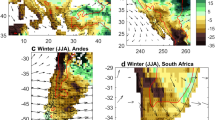Abstract
This paper investigates the dependence on environmental conditions of altitudinal precipitation differences in the northern Alps, based on high-resolution numerical simulations with the MM5 model for a selected region in the Bavarian Alps (Zugspitze mountain and surrounding valley stations). Three exemplary precipitation events representing climatological regimes with different orographic enhancement characteristics are selected. After validating the MM5 precipitation fields against the available surface observations, the model results are used to analyse the interactions of atmospheric dynamics and cloud microphysics with the local orography. The first two cases (19–22 March 1997, 05–09 February 1999) are characterized by a strong northwesterly or northerly flow, associated with large precipitation differences between the mountain and the surrounding valley stations. For these cases, the model results indicate a dominance of the classical seeder–feeder mechanism, with strong orographic lifting generating dense orographic clouds over each individual mountain ridge, which in turn intensify precipitation. The related surface precipitation maxima can be found near the mountain peaks or somewhat in the lee due to hydrometeor drifting. The third case (05–07 December 1992) represents conditions with relatively small (i.e. below climatological average) precipitation differences between the Zugspitze and the surrounding valley stations. For this event, the model results indicate that relatively weak ambient winds at and below Alpine crest level (700 hPa) were primarily responsible for the lack of substantial precipitation enhancement. Precipitation was nevertheless moderately intense because of strong frontal lifting at higher levels. In all three cases, the agreement between simulated and observed precipitation patterns is so high that there is good reason to expect that mountain–valley precipitation differences will be quantitatively predictable for nonconvective events once a sufficiently high model resolution is computationally affordable.








Similar content being viewed by others
Notes
Note that the dew point is defined with respect to water saturation, so that ice saturation implies a finite dew point depression at temperatures below freezing.
Mountain gauges are usually shielded to some extent, but not valley gauges.
References
Anders AM, Roe GH, Durran DR, Minder JR (2007) Small-scale spatial gradients in climatological precipitation on the Olympic Peninsula. J Hydrometeorol 8:1068–1080
Blumer F (1994) Die Höhenabhängigkeit des Niederschlags im Alpenraum. Diss. ETH Zürich Nr. 10784, 242 S
Bergeron T (1965) On the low-level redistribution of atmospheric water caused by orography. Supplement Proceedings of International Conference on Cloud Physics, Tokyo, May 1965, pp 96–100
Bresson R, Ricard D, Ducrocq V (2009) Idealized mesoscale numerical study of Mediterranean heavy precipitating convective systems. Meteorol Atmos Phys 103:45–55
Carruthers DJ, Choularton TW (1983) A model of the feeder–seeder mechanism of orographic rain including stratification and wind-drift effects. Q J R Met Soc 109:575–588
Colle BA (2004) Sensitivity of orographic precipitation to changing ambient conditions and terrain geometries: an idealized modeling perspective. J Atmos Sci 61:588–606
Choularton TW, Perry SJ (1986) A model of the orographic enhancement of snowfall by the seeder–feeder mechanisms. Q J R Met Soc 112:335–345
Dudhia J (1989) Numerical study of convection observed during the Winter Monsoon Experiment using a mesoscale two-dimensional model. J Atmos Sci 46:3077–3107
Frei C, Schär F (1998) A precipitation climatology of the Alps from high-resolution rain-gauge observations. Int J Climatol 18:873–900
Gantner L, Hornsteiner M, Egger J, Hartjenstein G (2003) The diurnal circulation of Zugspitzplatt: observations and modeling. Met Z 12:95–102
Grell GA (1993) Prognostic evaluation of assumptions used by cumulus parameterizations. Mon Weather Rev 121:764–787
Grell GA, Dudhia J, Stauffer DR (1995) A description of the fifth-generation Penn State/NCAR mesoscale model (MM). NCAR Tech. Note NCAR/TN-398+STR, 122 pp
Houze RA Jr (1993) Cloud dynamics. Academic Press, San Diego
Kain JS, Fritsch JM (1990) A one-dimensional entraining/detraining plume model and its application in convective parameterization. J Atmos Sci 47:2784–2802
Kain JS (2004) The Kain–Fritsch convective parameterization: an update. J Appl Meteor 43:170–181
Klemp JB, Durran DR (1983) An upper boundary condition permitting internal gravity wave radiation in numerical mesoscale models. Mon Weather Rev 111:430–444
Knoch K, Reichel E (1930) Verteilung und jährlicher Gang der Niederschläge in den Alpen. Veröff. Preusss. Met. Inst. IX, 6
Mlawer EJ, Taubmann SJ, Brown PD, Iacono MJ, Clough SA (1997) Radiative transfer for inhomogeneous atmosphere: RRTM, a validated correlated-k model for the longwave. J Geophys Res 102:16663–16682
Reisner J, Rasmussen RM, Bruintjes RT (1998) Explicit forecasting of supercooled liquid water in winter storms using the MM5 mesoscale model. Q J R Met Soc 124:1071–1107
Schwarb M (2001) The Alpine precipitation climate: evaluation of a high-resolution analysis scheme using comprehensive rain-gauge data. Diss. ETH Zürich, Switzerland, 131 pp
Shafran PC, Seaman NL, Gayno GA (2000) Evaluation of numerical predictions of boundary layer structure during the Lake Michigan Ozone Study (LMOS). J Appl Meteorol 39:412–426
Scorer RS (1949) Theory of waves in the lee of mountains. Q J R Met Soc 75:41–56
Smith RB (1979) The influence of mountains on the atmosphere. Adv Geophys 21:87–229
Smith RB, Barstad I (2004) A linear theory of orographic precipitation. J Atmos Sci 61:1377–1391
Tao W-K, Simpson J (1993) Goddard cumulus ensemble model. Part 1: model description. Terres Atmos Ocean Sci 4:35–72
Thompson G, Rasmussen RM, Manning K (2004) Explicit forecasts of winter precipitation using an improved bulk microphysics scheme. Part I: description and sensitivity analysis. Mon Weather Rev 132:519–542
Tustison B, Harris D, Foufoula-Georgiou E (2001) Scale issues in verification of precipitation forecasts. J Geophys Res 106:11775–11784
Yang D, Sevruk B, Elomaa E, Golubev V, Goodison B, Günther T (1994) Wind-induced error of snow measurement: WMO intercomparison results. In: Proc. 23rd Int. Tagg. f. Alpine Meteorologie, Lindau, Germany. Ann Meteor 30:61–64
Wastl C, Zängl G (2007) Analysis of the climatological precipitation gradient between the Alpine foreland and the northern Alps. Met Z 16:541–552
Wastl C, Zängl G (2008) Analysis of mountain–valley precipitation differences in the Alps. Met Z 17:311–321
Zängl G (2002a) Stratified flow over a mountain with a gap. Linear theory and numerical simulations. Q J R Met Soc 128:927–949
Zängl G (2002b) An improved method for computing horizontal diffusion in a sigma-coordinate model and its application to simulation over mountainous topography. Mon Weather Rev 130:1423–1432
Zängl G (2003) A generalized sigma coordinate system for the MM5. Mon Weather Rev 131:2875–2884
Zängl G (2005) The impact of lee-side stratification on the spatial distribution of orographic precipitation. Q J R Met Soc 131:1075–1091
Zängl G (2007) Interaction between dynamics and cloud microphysics in orographic precipitation enhancement: a high-resolution modeling study of two north-Alpine heavy precipitation events. Mon Weather Rev 135:2817–2840
Acknowledgments
The authors would like to thank the DWD (Deutscher Wetterdienst), the Austrian ZAMG (Zentralanstalt für Meteorologie Geodynamik) and the Austrian HZB (Hydrographisches Zentralbüro Österreich) for providing the observational data. The authors were partly sponsored by the German Science Foundation (DFG) under grants ZA-268/5 and ZA-268/6. The work also benefitted from cooperation with the GLOWA-Danube project, which is funded by the Bundesministerium für Bildung und Forschung (BMBF). The authors are also indebted to the Deutsches Fernerkundungszentrum of the DLR in Oberpfaffenhofen (DLR-DFD) that provided them with high-resolution topography data of the Alpine region.
Author information
Authors and Affiliations
Corresponding author
Rights and permissions
About this article
Cite this article
Wastl, C., Zängl, G. Mountain–valley precipitation differences in the northern Alps: an exemplary high-resolution modeling study. Meteorol Atmos Phys 108, 29–42 (2010). https://doi.org/10.1007/s00703-010-0083-y
Received:
Accepted:
Published:
Issue Date:
DOI: https://doi.org/10.1007/s00703-010-0083-y




